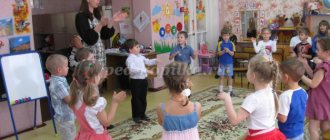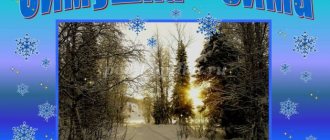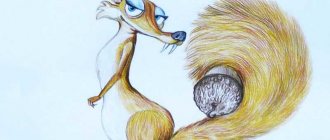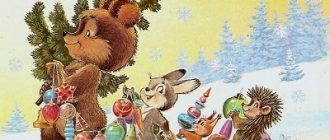Goal: updating the communicative capabilities of children with general speech underdevelopment during the study of the topic “Winter. Winter fun."
Tasks:
Correctional - educational
1. Strengthen ideas about winter and its signs. Clarify, expand and activate the vocabulary on the topic “Winter. Winter fun."
2. Improve the grammatical structure of speech: consolidate the ability to select and form words with the same root (snow, snowflake, snowfall, bullfinch, snowman, Snow Maiden, etc.), consolidate the ability to coordinate nouns with adjectives in gender and number.
3. Improve the ability to speak out on a given topic, compose descriptive riddles, and compare objects based on common features.
Corrective and developmental
1. Improve the ability to listen, analyze and solve descriptive riddles.
2. Develop phonemic awareness, the ability to select words for a given sound.
3. Develop visual and auditory attention, thinking, and speed of reaction.
Correctional and educational
Develop skills of cooperation, mutual understanding, goodwill, initiative, and the ability to work in small groups.
Equipment:
Scene picture “Winter fun” from the manual by Tkachenko T.A.
(“Pictures with a problematic plot for the development of thinking and speech in preschoolers” 1st issue) Appendix 1
, a set of pictures with related words for the word “snow”
Appendix 2
, subject pictures: dog, crow, skis, bench, closet, water, icicles, wind , tables for sketching riddles, felt-tip pens, syllables written on cards: GO, LU, BI, DO, MI, KI, snowflakes for each child, the “Tree of Related Words” manual, a snowball made of artificial snow, two easels.
Forms of organizing joint activities
| children's activities | forms and methods of organizing joint activities |
| Gaming | — game situation “Journey through the picture” |
| Communicative | - joint composing of riddles - telling descriptive riddles - children's statements based on the picture - questions - answers - d/exercise “Choose a word about which you can say...” — d/i “Auction” |
| Cognitive and research | - d/i “Choose related words” — creation of artificial snow |
| Fine | - a schematic representation of a descriptive riddle |
Logic of educational activities
| № | activity of a teacher | children's activities | Expected results |
| 1 | Organizing time The speech therapist invites the children to share their good mood with them and give each other a smile. | Children stand in a circle with a speech therapist, holding hands, shaking hands and smiling at the same time. | Concentration of attention, the mood of children for joint activities. |
| 2 | Didactic exercise “Find the picture” The speech therapist invites the children to find a place at the table: “Stand near the picture, about which you can say cold, (wooden, wooden, cold, wooden, cold).” The speech therapist asks the children to name the pictures near which they stood along with the attribute words. | Children, coordinating adjectives with nouns, find corresponding pictures located on the table in a circle. (skis, water, icicles, bench, closet, wind) , stand next to them, | The ability to differentiate gender and number endings of adjectives, coordinate adjectives with nouns in gender and number) |
| 3 | Didactic exercise “Collect a word” The speech therapist invites the children to turn the pictures over, divide into two teams based on the color of the written syllables, and each team compose a word from the syllables and read it. | Children are divided into two teams, lay out words from syllables and read them: DO-MI-KI, GO-LU-BI. | The ability to synthesize words from three open syllables in a broken sequence. Ability to negotiate and work in a small group |
| 4. | Didactic exercise “Make a riddle” The speech therapist gives the teams one subject picture each, invites them to stand near the easels and sketch a jointly invented descriptive riddle about this subject; if necessary, asks leading questions The speech therapist invites the teams to ask each other the resulting riddles. | Children work together to come up with a descriptive riddle about a dog (crow), schematize it in a table Children take turns telling each other and guessing riddles. | The ability to compose descriptive riddles based on comparing an object with others and finding common features. The ability to work together in small groups, the ability to listen to a friend, negotiate, and come to a common opinion. Modeling skills, imaginative thinking. |
| The ability to emotionally, meaningfully talk about objects, listen carefully to comrades. Development of thinking. Ability to solve descriptive riddles. | |||
| 5 | Didactic exercise “Walk through the picture” The speech therapist suggests remembering where they have already met the characters in the guessing pictures. The speech therapist reminds the children that they have already looked at this picture with the help of a “spyglass” and invites the children to go into the picture with the help of magic assistants (“magic ears”, “magic hands”, “magic nose”, “magic tongue”) | Children remember the picture “Winter Fun”; tell what they feel in the picture with the help of “magic hands”, tell what they hear in the picture with the help of “magic ears”, tell what they feel in the picture with the help of the “magic nose”, list what they feel with the help of “ magic tongue." | The ability to construct coherent statements and speak freely on a given topic. Development of creative imagination. |
| 6 | Didactic exercise “Interview” The speech therapist “interviews” children by addressing their senses: “Magic ear, what did you hear?” “Magic nose, what did you feel?”, Magic pen, what did you feel?” “Magic tongue, how did you feel?” The speech therapist gives each child a snowflake for their performance. | Children answer questions and talk about their journey through the painting through their senses. | Ideas about the properties and qualities of various objects, the ability to compose a coherent statement; observation and intelligence. The ability to participate in a conversation, answer the teacher’s questions, express one’s opinion, and give arguments. |
| 7 | Didactic exercise “Tree of related words” The speech therapist offers to go to the tree of related words and put snowflakes near its trunk, asks to name what lies near the tree trunk; suggests looking at the object pictures on the table, selecting among them related words to the word snow and attach to the tree of related words. | Children lay out snowflakes and call their word is snow; choose among subject pictures related to the word | The concept of related words. The ability to select related words to a given word. |
| 8 | Didactic game "Auction" The speech therapist suggests arranging an “Auction” game with the crow (the last one to name a word with a given sound wins); gives the task to determine what sound the black, croaking crow wished for? | Children determine the given sound [r], select words with this sound. | The ability to select words with a given sound. |
| 9 | Surprise moment “Gift from a painting” The speech therapist shows the children artificial snow - a gift from the painting - and invites them to examine and touch it. Explains to the children that they can make such artificial snow themselves, if they want, from materials prepared in the group. | Children look at the snowball and share their impressions; They go out into the group and independently make artificial snow according to an algorithm and diagram from starch and shaving foam. | Cognitive interest; development of fine motor skills; relieving emotional stress. |




